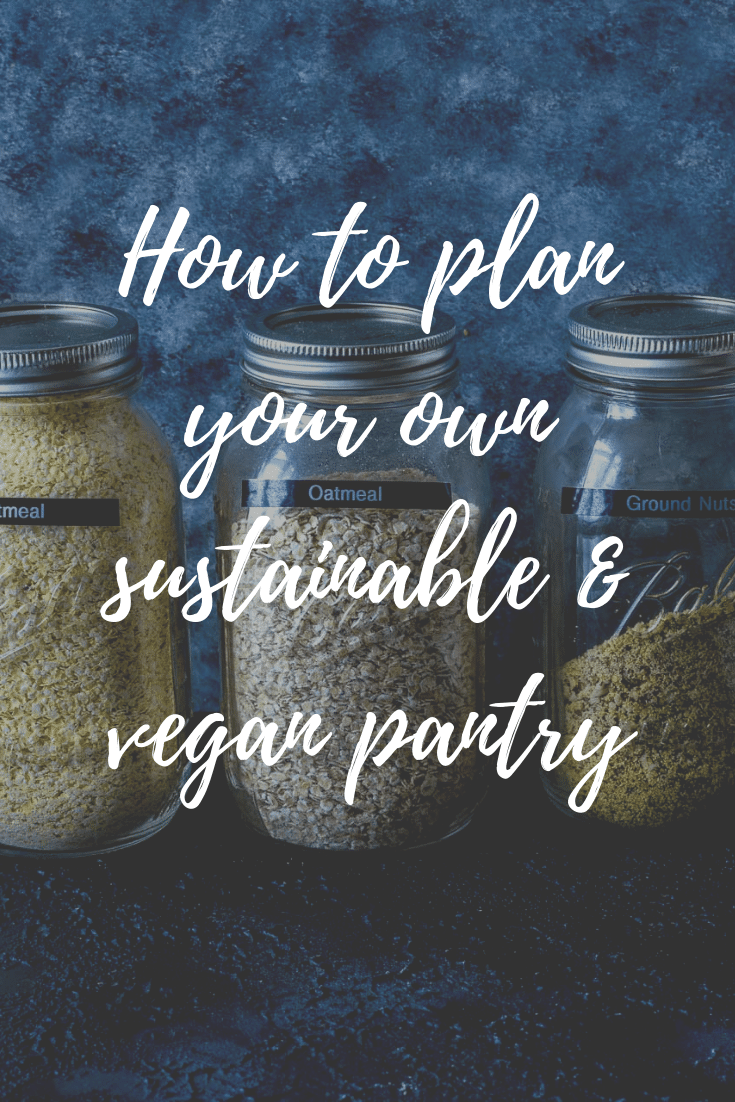This blog post also is available in German.
The time has come to plan, design and implement your sustainable vegan pantry. If you want to stock up, but one of the above steps is difficult, you’ve come to the right place. Today we analyze the space conditions in your kitchen. And with the ideas listed down below you’ll hopefully find a place to store your supplies somewhere. Further you`ll be able to identify your most important ingredients with my strategy. The ones which may not be missing in your pantry. In a last step, I’ll tell you the perfect sustainable storage options. As a summary there is a downloadable fact sheet at the end of this article.
Make the most of your space
1. Analyse your space conditions
Ask yourself whether space is available and how you can make the most of it. Open all cupboards and drawers. Do you have free walls to hang a shelf? Maybe you have a storage room that can be converted? If so, you can start by finding the perfect storage system for your storage (see point three). You can’t find a place at first sight? Then go on to step 2. Of course you can also go through step 2 if you have enough space. It is extremely satisfying to clean out and reorganize everything.
2. Create space
Now it`s time to inspect and clear out. Before you start, think carefully about which areas you want to divide your kitchen into. For example:
- pantry
- cooking supplies
- cleaning utensils
- kitchen machines
- tableware
Work your way systematically through all your cabinets, drawers and shelves. Sort the items in them according to your defined categories. At the end you should have a stack for each group. Now take a look at the individual utensils.
- Which items have you not used for a long time?
- What is in a desolate state?
- Do you have incomplete utensils? The classic are containers where lids are missing.
- What do you not depend on, respectively what do you not really need?
- What do you no longer like?
You could dispose of, give away or donate those items to which one of these questions applies. This will make room for your pantry! Now you assign each group a place where you`re going to store them. And make sure to count in some space for your supplies.
If you find it difficult to separate items or if you have general difficulties with the organisation in your kitchen, I can recommend Marie Kondo or the following book (bought it myself). The latter helped me a lot to bring order to my housekeeping.
3. get creative – find unconventional ways of storage
You have gone through step 1 and 2, but somehow still haven’t found the optimal space solution? Another scenario: you have enough space for your storage and are now looking for a storage system that suits you?
“Think outside the box” is a very good tip here. How about a hinged pantry, a hanging system, a wall shelf? A small chest of drawers that you can fill with glasses and containers? Maybe you have space for corner shelves, hanging shelves, a peg board or wire racks for kitchen cabinets. There are countless creative ideas on how to store things – including supplies – in a small space.
The best place to look is Pinterest, where you’ll find great ideas. The IKEA site also has great storage system ideas. You’ll also find a lot of inspiration in the book mentioned above.
Define your pantry essentials
When we talked about bulk shopping, I already mentioned it. It`s essential to identify your most important stocks. This applies not only to unpacked shopping, but also if you plan a sustainable vegan pantry. You have trouble identifying the ingredients? Are you undecided what you need? Or do you have limited space for your pantry? Then the next steps will help you to define your most important ingredients.
- Write down all available food on a list or write down all ingredients you need at least once a week.
- Give each food a number depending on how often you use it. 1 for the least and 10 for the most. For example, I need coffee every day, so it`s a 10, and oatmeal several times a week, so it’s a 9. I rarely need semolina, so it’s more likely a 2. I still have a lot in stock though as I’m a food blogger, but that doesn’t have to be like that with you.
- All food with high numbers, for example 7-10 will definitely be in your pantry. If you have a little more space, maybe the items with numbers ranging from 5 to 10.
- Don’t forget to adjust the amount of selected food to the available space. It doesn’t help to set 20 ingredients if you can’t store them afterwards.
Maybe you just started a vegan diet and are unsure which ingredients you need? Then you are welcome to have a look at my pantry essentials list. You can download a shortened list as a pdf file or simply save it on Pinterest. Otherwise you can get my free pantry guide with the most important food for a vegan pantry.
How to store sustainably
To plan a sustainable vegan pantry also requires the right choice of storage containers. Sustainable storage means using materials that are as durable and environmentally friendly as possible. Plastic is definitely not one of them. However, if you already have plastic or similar containers at home, that are still in perfect condition, then of course you don’t have to throw them away. It’s just about not buying more plastic.
If this is not the case, glass would be the recommended material! It`s sustainable, durable and hygienic. Furthermore, it does not absorb odours and is easy to clean. In the case of mason jars – in contrast to regular screw glasses – I have personally experienced that they also protect against vermin such as food moths. Beautiful mason jars are available at Pinkfisch, Lieblingsglas, Koro or myglass.
However, new purchases are not absolutely necessary! Absolutely sustainable is reusing glasses with food in them. Finish the food they contain, then simply rinse and soak them to remove labels and you can fill them with your supplies. This will take a little longer until you have enough glasses together though. By the way, I do a mix of both.
Once you have decided on your prefered storage containers, you determine how many of them you need. This is very quick, as you have already defined your must haves in a previous step. That’s how many containers you need.
Now you fill your food into the glasses. The best way to do this is to shop a bulk store, to not generate any waste. It is also advisable to label the glasses. I do this with a labeling machine. Thus I always know what is in the glasses. In addition, each jar has an allocated ingredient. After all, you don’t always want to re-label. But you can also write on the lids with chalk or use other labeling techniques. A labeling machine is not a must.
Voilà now you know everything you need to plan and design your own sustainable vegan pantry. Have fun with the implementation!
Read you soon
your Sarah




